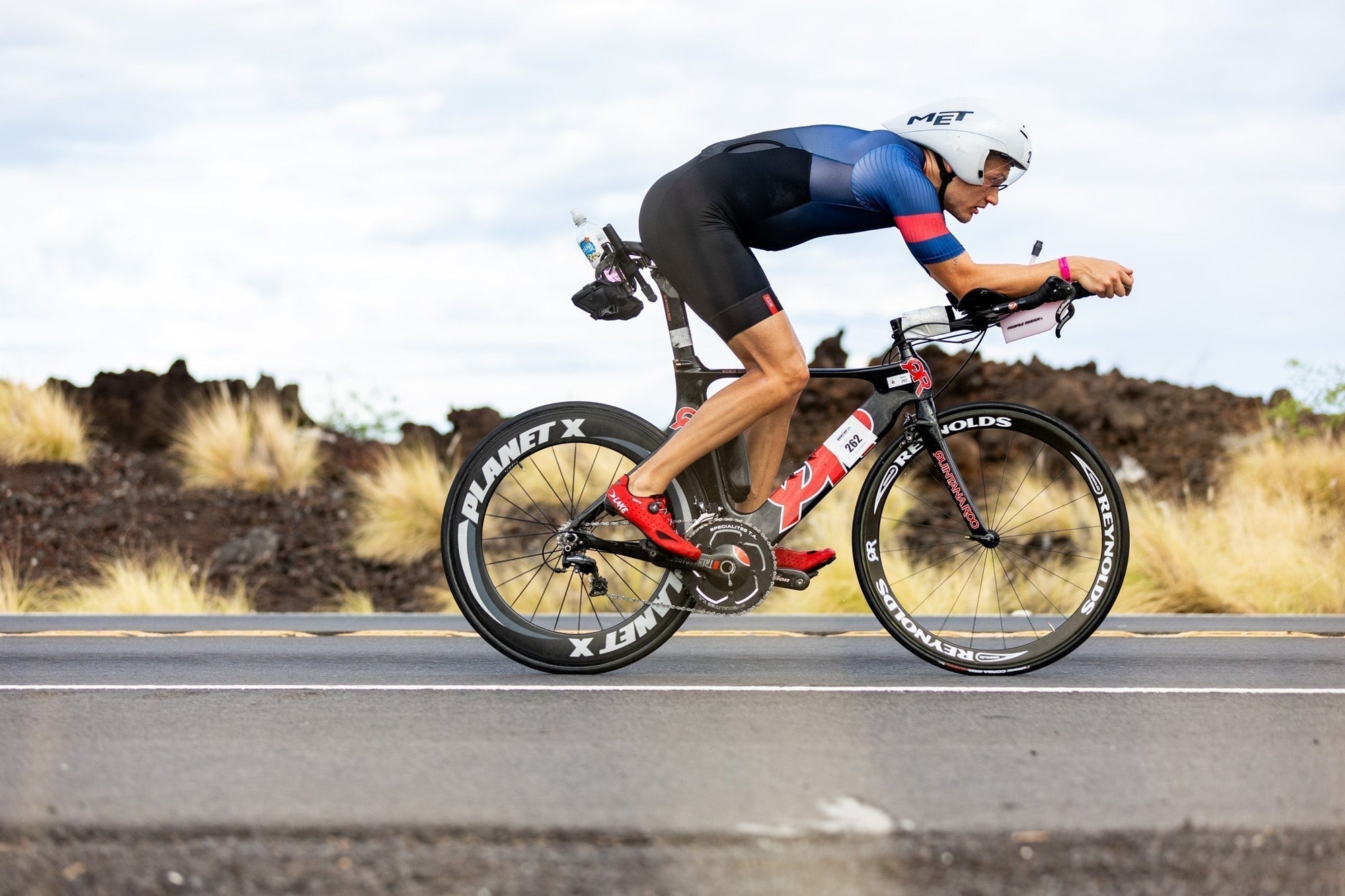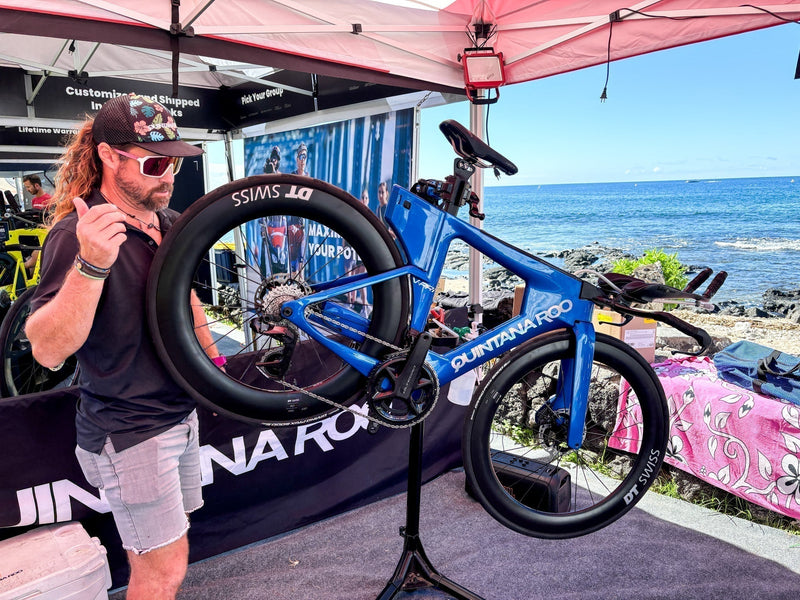DISC VS. RIM BRAKES: IS UPGRADING TO DISC BRAKES WORTH IT?

Pretty much every modern triathlon and road bike now comes equipped with disc brakes. But every once in a while, we get a blast from the past when an athlete comes by with an old Quintana Roo PR Series or CD0.1. There’s nothing wrong with these bikes, or with the rim brakes they use. They’re fast as heck! However, athletes still riding rim brakes may wonder if “upgrading” to a triathlon bike with modern hydraulic disc brakes is worth it.
The simple answer is YES, disc brakes are definitely worth it. But there’s some nuance to this. Of course, no one NEEDS disc brakes. Rim brakes have worked for over 100 years, and they still work today. If you have a rim-brake bike that rides well, there’s no reason you need to spend money on something shiny and new.
That said, if you have the upgrade itch and need a little push to get on a new disc brake bike, we’ve got you covered. There are plenty of compelling reasons to get a disc brake triathlon bike, and we’ll cover all the key pros and cons so you can make an informed decision.
Disc vs. Rim Brakes: Braking Power & Control

-
Disc brakes provide better stopping power and modulation
-
Disc brakes can improve handling and safety
-
Disc brakes can allow you to brake later and corner faster
-
Disc brakes work much better in wet conditions
Increased braking power is the biggest advantage hydraulic disc brakes have over rim brakes.
Triathlon bikes often have a reputation for being tough and awkward to handle. At Quintana Roo, we design our bikes to have the most intuitive and confidence-inspiring handling possible, but still, having more braking power at your disposal is always a good thing! With the increased power, you also get a lot more modulation. With hydraulic disc brakes, it’s simply easier to control them to get the exact amount of braking power you want or need.
Being able to access all of your stopping power from an aggressive aero position and using less energy or strength to access that stopping power could save your skin if you need to stop quickly in an emergency. Not only that, it could even help you ride faster. Having more confidence in your brakes means you can attack downhills and corners that little bit faster, shaving precious seconds off your finish times.
Disc brakes also have a huge advantage in wet conditions. This is especially true for riders using carbon wheels. Rim brakes on carbon rims are notoriously ineffective when wet. I’d call them terrifying—potentially dangerous. Having consistent braking power in any weather condition is a huge bonus.
Disc vs. Rim Brakes: Aerodynamics

-
Rim brakes are only slightly more aerodynamic
-
Newer designs integrate disc brakes into aero frame shapes
-
Disc brakes allow bikes to use more aerodynamic rims
We’ve done a lot of wind tunnel testing here at Quintana Roo, and there’s no getting around the fact that old-school rim brakes are easier to hide from the wind. However, the advantage is actually quite small. We might see a difference of 3-7 watts at high speeds (45-55+ kph), but at more realistic speeds (25-35 kph), the difference shrinks to as low as 1-1.5 watts.
 The big thing to know is that the front forks on modern disc brake bikes are being designed to minimize the aerodynamic impact of disc rotors and calipers (see the aero caliper cover in the image above). Engineers have gotten so good at designing around disc brakes that the aero difference is becoming negligible. (Disc brakes definitely didn’t hold Kristian Høgenhaug back when he broke the IRONMAN bike course record!)
The big thing to know is that the front forks on modern disc brake bikes are being designed to minimize the aerodynamic impact of disc rotors and calipers (see the aero caliper cover in the image above). Engineers have gotten so good at designing around disc brakes that the aero difference is becoming negligible. (Disc brakes definitely didn’t hold Kristian Høgenhaug back when he broke the IRONMAN bike course record!)
Also, it’s worth considering that disc brakes open up rim design and allow for much wider rims. Because you can use much more aerodynamic wheel designs, it can actually offset the aero penalty of having disc brakes (more on that below).
Disc vs. Rim Brakes: Tire & Wheel Options

-
Disc brakes give you more modern wheel and tire options
-
Modern wheels and tires offer huge performance gains
With old-school rim brakes, wheel design was limited by the clearance that rim brake calipers offer. With the move to modern disc brakes, aero rim designers have more freedom to design rims that optimize aerodynamics. Today’s carbon disc brake aero wheels are faster than ever, and they offer a host of other benefits too.
Modern disc brake wheels make it easy for riders to use wider modern tubeless tires, which offer lower rolling resistance, better puncture protection, and more comfort and traction. Deep-section aero rims can also be made lighter, because they don’t need to be reinforced at the rim to handle braking forces.
Disc vs. Rim Brakes: Weight
-
Rim brakes still weigh less
There’s no contest here. If weight is your top priority, a rim brake setup is always going to be lighter than a hydraulic disc brake setup. They’re just simpler and have fewer parts. The real question is: does it matter?
For me, weight is very low on the list of triathlon bike priorities. (Quintana Roo tri bikes are among the lightest in the world, so I am a bit spoiled.) For me, aerodynamics, braking power, and good wheel and tire options are far more important and make a far bigger difference in your finish times.
Disc vs. Rim Brakes: Maintenance & Cost

-
Rim brakes are cheaper and easier to maintain
-
Disc brake maintenance can be intimidating for home mechanics
-
Disc brakes extend the lifespan of your rims, saving money
Hydraulic disc brakes are much more complicated than rim brakes, which means they require a bit more maintenance. In most cases, hydraulic disc brakes should get a yearly bleed, which can be intimidating for athletes who aren’t mechanically inclined, and will add to maintenance costs if you’re relying on a bike shop. Brake squeal and brake rub are also more common with disc brakes. While these issues are easy to fix at home, they will annoy rim brake aficionados.
While the cost of maintenance and parts is generally higher for disc brakes, they do offer one huge benefit: they spare your rims. Because rim brakes use the rim itself as a braking surface, the wheel becomes a wear component. Back in the day, athletes used to train on cheap aluminum wheels and save expensive carbon wheels for race day to try and preserve them for as long as possible. If you ride a lot (~10,000 miles/year), you might burn through a set of rims every few seasons. With disc brakes, though, rims can last the lifetime of your bike, saving money in the long run!
Final Thoughts

So, should you go out and buy a disc brake triathlon bike tomorrow? If you have a perfectly functional bike at home, then probably not. But if you’re shopping for a new bike, you likely won’t have much of an option because disc brakes have become the standard. Maybe knowing the benefits of this modern technology could be the thing that pushes you toward upgrading. If you do upgrade, you might wonder why you stuck with rim brakes for so long!



